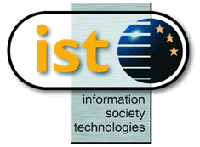



LONG (Laboratories Over Next
Generation Networks, IST-1999-20393)
Start date: 01/12/2000
End date:
31/01/2003
Web site: http://www.ist-long.com
See partners
Contact person: Carlos Ralli Ucendo (ralli@tid.es)
Mission: LONG aims to foresee
and solve problems related to the design and deployment of Next Generation
Networks and Advanced user applications.
Our rules of the thumb to achieve this are:
Integration: IPv6, different access & transport
systems, transition scenarios, advanced services and applications are
tested to integrate all of them into a single platform.
End-user orientation: All elements in the stable test-bed
are introduced to provide benefits for user/network services. For example,
the transition mechanisms are only introduced in the stable platform
when needed by the network/user services (IPv4/IPv6 clients/host interaction).
Hosting Real Events: a complex application (Isabel)
is used for real events: stability and rational deployment are a must.
Basic Infrastructure
The LONG network, based on
IPv4/IPv6 is fully deployed. You can see a map of the network
currently deployed. The LONG network includes equipment from different
vendors (Cisco, Ericson Telebit, FreeBSD routers, Linux routers). The core
is based on ATM dedicated links, and on IPv6 tunnels over IPv4 commodity
internet. Recently, IPv6 connectivity over DWDM has been established between
Universidad Carlos III and Universidad Politécnica de Madrid, with
an intermediate hop at Telefonica I+D premises. The DWDM infrastructure
has been provided by the Spanish National R&D project PREAMBULO. In
the edges, access technologies like ADSL or Wireless LAN. For some technologies
(for example, for CATV), there were no appropriate implementations in the
time of testing.
You can use IPv6 traceroute to trace the path from your
PC to the LONG Web Server. BGP4+ is used for exchanging routing information
among the partners. Some of them use RIPng for internal routing. Have a
look at LONG routes ,BGP4+ and RIPng, from UPC
router).
Deployed IPv6 user services
Standard IPv6
Applications
The services provided by
the LONG network (among others) are:
Web - Try some of the
different IPv6 web servers:
http://www.upc.long
(The LONG Web page)
http://www.upm.long
http://www.uc3m.long
http://www.tid.long
http://www.uev.long
FTP – Several IPv6 FTP
servers are installed in the LONG network. You can try some of them
(they have anonymous access):
ftp.upm.ist-long.com
ftp.tid.long
News - A IPv6 news server is installed on the LONG Network. Several newsgroups are available, the all "comp.*" hierarchy, and also the "linux.*". "This" browser is properly configured to access this news server, you can try it.
Mail - The IPv6
Mail service is also provided, fill out this form and you will send an
IPv6 mail to any IPv4 user.
LDAP - Two LDAP servers
are running on the LONG Network, they have the information of all
the people working on this project. You can make a query to them.
IRC - Two IRC
servers are running in the LONG network, we use them to coordinate
the events and the experiments. You can try a CGI to join the UC3M
IRC server, and speak with some of the LONG members. Find more
information about this CGI below. You can also access a IRC server using
xchat.
DNS - The ".long"
domain is used at the LONG network. Each partner has its own domain
(".upc.long, .upm.long, .uc3m.long, .tid.long, .ptin.long, .uev.long
and also the *.ist-long.com domains"), you can make a query to the DNS
server filling out this form.
Proxy - A proxy
server (Squid Version 2.5-DEVEL) is installed in the LONG Network. Its
particularity is that both the Squid and the machine are IPv6 enabled,
by configuring your browser to use this proxy, you will be able to navigate
through the 6bone or the LONG IPv6 backbone from an IPv4-only machine
in the Internet. The proxy provides HTTP and FTP connectivity to IPv6
networks (and also IPv4 networks).To use this service you
have to configure your browser to use “proxy6.ccaba.upc.es” (147.83.130.132:3128)
or 3FFE:3326:3:916::305 port 3128. Take a look at this screenshot
of Netscape Navigator (running in a IPv4 only machine) using the proxy surfing
the 6Bone (www.kame.net).
Applications ported to IPv6
Under the LONG project
several applications have been developed. This enables us to better understand
the implications of IPv6 deployment. Most of them are part of the stable
LONG network.
Isabel - The
ISABEL application has been ported to IPv6. You can see this application
working in a PC close to this one. You can learn more about ISABEL.
Mgen6 - Mgen6 is
an IPv6 upgrade of the popular Multi GENerator Toolset (MGEN) traffic
generator and analysis tool (read more info about it
and its porting). Here you can view an example test of MGEN. The netperf
application has also been modified to be able to make tests over a network
using SOCKS64 translation.
Netmeter - Netmeter is an interactive Graphical User Interface to simplify the traffic generation and information gathering for network testing environment. You can learn more about NetMeter.
A Video Streaming and MP3
client/servers.
Afoto - A
funny application that takes a picture from you and sends it from LONG
IPv6 Mail Server to whatever mail server that manages the destination
address (either IPv4 or IPv6). Once received, the addresses of the servers
(IPv4 or IPv6) can be viewed in the mail headers.
IRC-CGI - A
CGI (using http over IPv6) to access to IRC. You can use it to join one of
the IRC servers of the LONG project.
Some distributed games (you
can try a few of them);
Quake
2 - Try it! You can play against
bots (automatic players) that run on an IPv4 machine behind a NAT-PT
box.
TEG –Try it! A turn-based
game.
Mangband – A rogue-like game.
If you want to download
these applications please, go to the LONG Web Page: http://www.ist-long.com
With this porting effort,
we have identified several key issues in porting
applications from IPv4 to IPv6. Maybe you can benefit from our experience.
IPv4/IPv6 transition
and interoperability
You can access an extended discussion about
IPv4/IPv6 transition and interoperability.
On one hand, the LONG network
makes extensive usage of configured tunnels (although we have tested
more tunnel flavours: 6to4, automatic, 6over4). Our experimental results
show that the use of tunnels does not reduce performance significantly
(if you want to read the description, see Deliverable
4.2, where you can find performance tests for several IPv4/IPv6
transition mechanisms).
For IPv6 applications that
require interaction with IPv4 ones, we use dual-stack hosts and translation
mechanisms.
Dual-stack hosts: A server can
be deployed in this way to allow IPv4 and IPv6 clients accessing the
service. In the LONG network the deployment of DNS, Web, FTP, IRC, Mail,
News and Isabel follow this approach. To consider the particular case
of Isabel, IPv4 clients and IPv6
clients can connect to a FlowServer running in a dual stack host, since
this component handles communication with both network protocols.
Translators are also used:
In the stable LONG infrastructure,
Isabel, NFS and the Tetris game are translated by NAT-PT (the most
mature and universal translation service) to allow IPv4 nodes to access
IPv6. IRC is translated using TRT. You can see
a map of UC3M, to see the topology of the network in which NAT-PT
is exercised. NAT-PT has proven to offer enough performance when not
too many flows are translated simultaneously, even to fulfil the real-time
communication requirements of Isabel.
In brief, the list of transition
mechanisms tested is: NAT-PT
, 6to4
, DSTM
, Configured
Tunnels and Tunnel Broker , Automatic
Tunnels , SOCKS
64 , TRT
You can see performance figures about some of them in Deliverable
4.2).
Different experiments have
been proposed for the LONG Network (see the proposal in Deliverable
4.1 and Deliverable
4.3, and some results at Deliverable
4.2; Deliverable 4.4 [to be published], to be issued by the
end of November, will show the rest of the results).
Measuring link bandwidth
and delay with Mgen6.
Transition mechanisms tests
(see description above).
Tests for different access
and transport technologies.
Mobility Tests - Several mobility solutions based on the Mobile IPv6 protocol have been tested locally by some partners. In addition, multi-partner mobility tests have been performed,
allowing a Mobile Node from one partner to be connected to another partner's network, and move from one network to another keeping existing connections with Correspondent Nodes.
Take a look at this graphic.
Multicasts Tests - Some IPv6 multicast experiments have
been performed over the LONG network. PIM Dense and Sparse Mode have
been tested. As IPv6 intermediate routers between all partners are not
IPv6 multicast capable, IPv6 multicast tunnels over IPv4 were used. To perform these tests LONG used
FreeBSD platforms and the RAT application. Take a look at the Multicast network
map.
Multihomming Tests - Exercising
tunnelling solutions, BGP solutions and the behaviour of address
selection in multi-homed environments. Take a look at this graphic.
Premium IP - As a result of the
collaboration with SEQUIN project and NRN´s, the LONG project
has been able to deploy a backbone with IPv4-level guarantees in some
of it's links. These guarantees are provided by configuring Differentiated
Services classification in the routers of NRN PoPs as well as those
of GEANT for the Madrid-Lisbon link. Priority IPv6 traffic is tunneled
through IPv4 tunnels with DSCP=46 (Expedited Forwarding) in the ToS field,
and thus, the diferentiated treatment is applied to IPv4 packets.
Differentiated Services - QoS Tests:
Apart from the deployment of the stable diffserv backbone, additional
QoS tests (focused on diffserv) are being performed. These tests served
us to verify that there is no conceptual difference between the provisioning
of diffserv in IPv4 and IPv6 environments. The only limitation in
IPv6 is the availability of products with full support for classification,
marking, and scheduling of IPv6 packets. LONG has tested some of the
IPv6 implementations of diffserv (Cisco's IOS Beta, FreeBSD, and Linux)
to determine the extent of its QoS support and to compare its IPv4
and IPv6 performance.
Advanced tests (advanced
functionality, deployment over mixed IPv4/IPv6 networks, performance,
etc.) with most of the applications described above.
Trials with real users
Supporting Trials involving
real users is also an important LONG activity:
IPv6 Forum 2001 - Distribution with
ISABEL of IPv6 Forum
2001. January 2001. Participants: LONG members: UPM (Spain), UPC (Spain),
UC3M (Spain), UEV (Portugal), PTIN (Portugal), UNAM (Mexico), ETRI (Korea), ICSI (USA), CRC (Canada), ULB (Belgium),
MCLAB (Switzerland). Take a look to the conference map.
This event was distributed using Isabel
IPv6 Forum 2002 - Distribution with
Isabel of IPv6 Forum 2002. March 2002. Participants: PTIN (Portugal),
UPC (Spain), MCLab GmbH (Switzerland), Berkeley University (USA),
Université Libre de Bruxelles (Belgium), ETRI / PEC (Korea), University of Evora
(Portugal), UPM (Spain), UC3M (Spain), TID (Spain), RedUNAM (Mexico),
Communications Research Centre Canada (Otawa).
The event was distributed using ISABEL over IPv6.
Here you can find some maps (network_map
and network documentation) describing the infrastructure
deployed for this distribution. A
demo of the LONG services was also available.
2002 Valencia Campus Party -
The Campus Party is an event
that joins together people from Europe and Latin America to share experiences
related with computers and communications. This event, that was first
organized in 1997, was held in August
2002 with 3000 users. This year, the Euro6IX project provided IPv6 connectivity,
and the services provided by the LONG were open to all the participants:
DNS, IRC IPv6, mail SMTP IPv6, the aFoto
application, video streaming, ISABEL, web, ftp. Take a look to
the network
map.
- Most of LONG project meetings have been hosted
using ISABEL over IPV6.